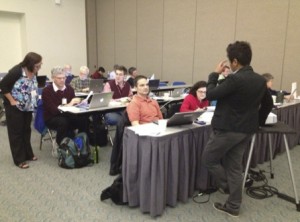Would you like to learn about conceptual climate models and teach them to your differential equations and modeling classes? Check out the online materials from the MAA Conceptual Climate Models Short Course at the JMM. The course was developed by a team from the Mathematics and Climate Research Network (MCRN) led by postdoc Esther Widiasih. There are recorded lectures, PDF slides and a 37-page workbook of sample exercises.
The course was 50% lectures and 50% hands on sessions. The lectures by Hans Kaper introduce global and zonal energy balance models (EBMs), demonstrating how accessible the material is for undergraduates, and including ideas of bistability and bifurcation to a Snowball state. The lecture by Dick McGehee extends the one-dimensional (zonal) EBM to include a dynamic iceline, then explores how well the EBM explains glacial cycles and other features of the paleoclimate record when forced by Milankovitch cycles in Earth’s orbit. The lecture by Esther Widiasih discusses ways to incorporate the effect of CO${}_2$ in the EBM, and related open questions.
The hands-on sessions, designed to build on each lecture, were run by Esther Widiasih, Anna Barry, Samantha Oestreicher and Dick McGehee. The worksheets include theoretical and computational exercises to develop intuition for the basic EBMs, together with simulations of the EBMs to explore the interplay between energy balance, ice-albedo feedback, Milankovitch cycles in Earth’s orbit, greenhouse gases and other feedback mechanisms. While the exercises are written to be software independent, a MATLAB guide is provided for each worksheet. Some of the participants volunteered to create similar guides using Mathematica and SAGE, so they will be coming to the website soon.
We hope you’ll join us in continuing to beta-test the materials, and that you will send us suggestions for improvements and additions, and tell us about our typos! You can send feedback to info@mathclimate.org.


Pingback: Prospects for a Green Mathematics « Azimuth